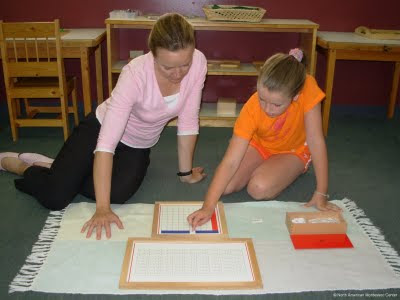I quietly observed the children, ages 3-6, enter the Montessori classroom and it was as if the materials called to the children to take them off the shelves and get to work. There was no jostling about or loud voices. There was calm; there was purpose. There was intense concentration. There was work!
A few years later, I began my Montessori life teaching in the upper elementary Montessori environment. My “big kids” were accustomed to using the materials and if any untoward usage occurred, I was able to quickly refocus it with a glance.
Things changed when I entered the Montessori lower elementary environment. I found myself with several students who had never been in a Montessori environment before and they regarded the materials as toys rather than work. As my normalized Montessori students looked on aghast, I quickly realized it was time to start from the beginning and take time for lessons in how to properly use the materials.
Using Montessori Materials: Helping Students Enjoy Work and Respect the Classroom
The Golden Rule: Treat the materials with respect!Modeling desired behavior is one of the best gifts we can give a child. I knew right away that in order to leave the biggest impression on my students, I would have to model the appropriate use of materials. I went around the room and quietly invited several students to join me by whispering “I have something to show you. Would you like to meet me at circle?” When I arrived back at circle, several beaming faces were ready for my lesson.
I silently got up and got my work rug and came back and slowly and deliberately unrolled it and smoothed it out. I then looked up at each child and smiled. I left again and wordlessly gathered my materials and placed them deliberately on the mat. I looked up, smiled again, and said quietly “This is my gift to you. This lesson was specially chosen to show you how special our materials are. This Montessori classroom is our home and each material in it has a special purpose. We treat our materials with respect, just as you would like me to treat your materials in your own home.”
Deviations will occur
Every new material is presented to the child using a fundamental lesson of use. The teacher, through observation, usually presents the material individually to each child when that child is ready. Montessori said that children not only need lessons that are interesting, but they also like to be shown exactly how to use the materials. Montessori understood that children are profoundly attracted to precision and these intricacies help keep their focus and attention.
Once the child has been shown how to use the material, the teacher invites the child to use the materials independently. If the child continues successfully, the teacher quietly steps away. If the child is unsuccessful, rather than correcting, the teacher merely suggests the material be put away for another day and the lesson is repeated at another time.
Sometimes children who were once successful using a material find themselves distracted and using it inappropriately. Here are some suggestions on how to redirect inappropriate use of Montessori materials without correcting the child:
- Quietly bend to the child’s level, look him/her in the eye and simply ask “Would you like a lesson on that material?” If they say no, ask them “Then, would you please demonstrate the appropriate way to use that material?”
- Ask the child to give you a lesson with the material. “Sherri, I haven’t used the long division work in quite a while. Do you think you could give me a lesson on it, please?
- Join in the work. “Oh, you’re using the Puzzle Map of Europe. That’s my favorite. May I work with you?”
- Sometimes, it’s best to simply suggest the material be put away. “I see you are finished with snack. Thank you for putting everything away neatly.”
Some related NAMC blogs:
As much as possible, NAMC’s web blog reflects the Montessori curriculum as provided in its teacher training programs. We realize and respect that Montessori schools are unique and may vary their schedules and offerings in accordance with the needs of their individual communities. We hope that our readers will find our articles useful and inspiring as a contribution to the global Montessori community.
© North American Montessori Center - originally posted in its entirety at Montessori Teacher Training on Wednesday, July 6, 2011.
© North American Montessori Center - originally posted in its entirety at Montessori Teacher Training on Wednesday, July 6, 2011.



0 comments:
Post a Comment
Have questions or comments? Let us know what you thought about this article!
We appreciate feedback and love to discuss with our readers further.